Animal vision nsta 102911
Download as ppt, pdf2 likes1,075 views
1. Animals see the world differently than humans due to variations in their visual systems, including differences in photoreceptor cells, eye structures, and neural processing. 2. Many animals have adaptations that allow them to see in dim light or detect polarized light, ultraviolet wavelengths, and motion. These adaptations relate to an animal's habitat and behaviors. 3. Studying animal vision can provide insights into designing improved cameras and visual processing systems by exploring solutions found in nature.
1 of 30
Downloaded 17 times
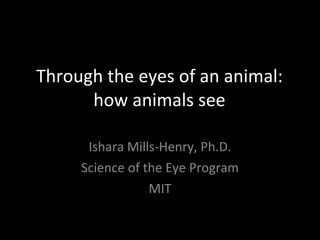
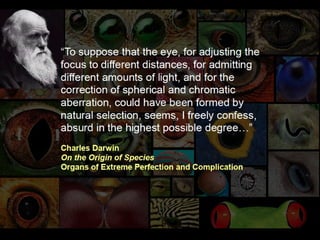
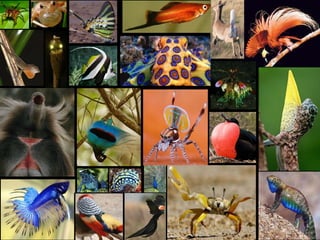
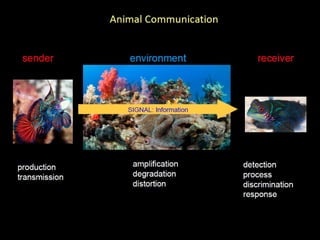
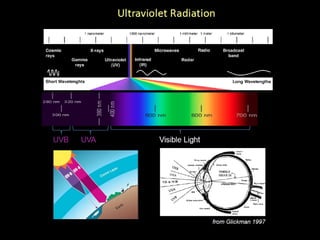

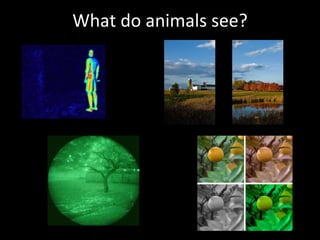
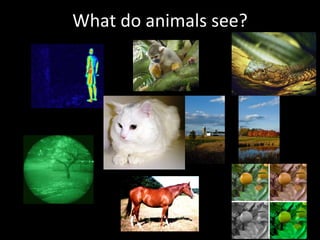
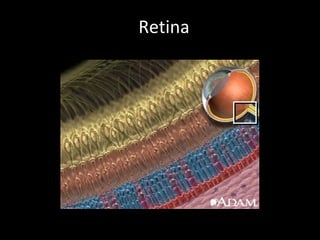
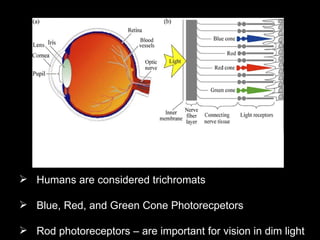
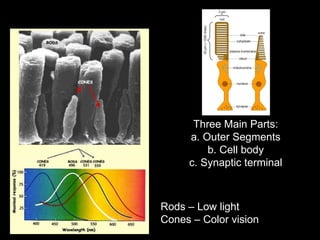
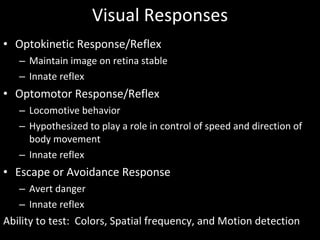
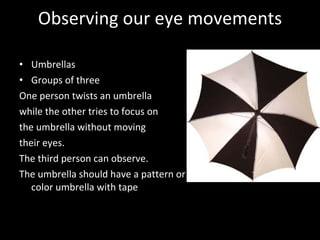
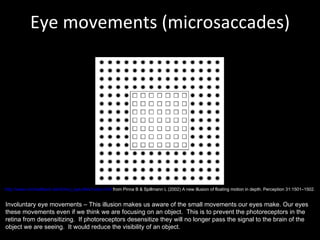
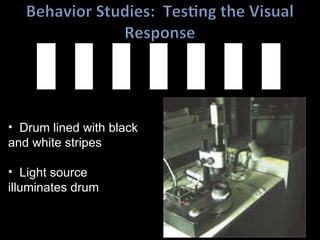
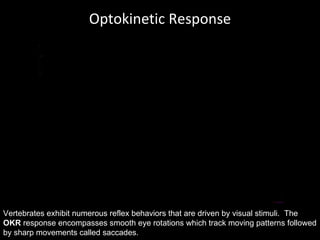
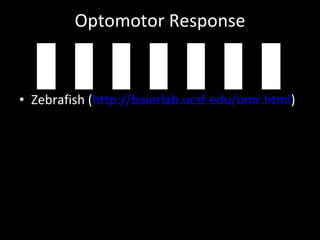
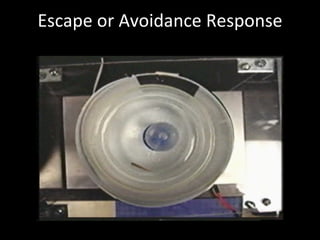

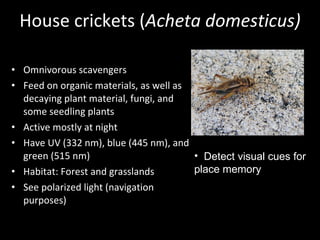
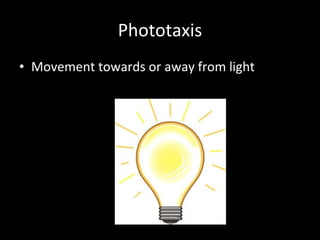
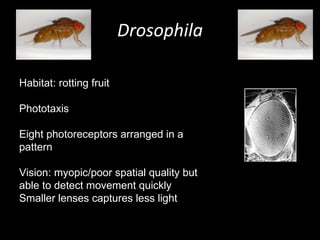
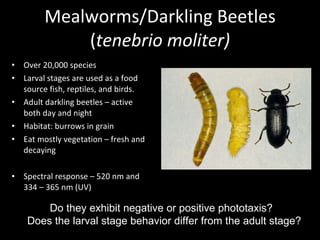
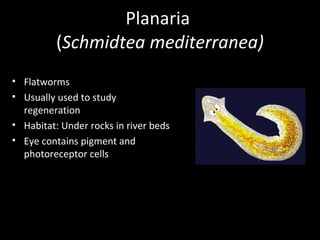



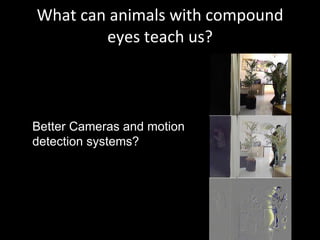

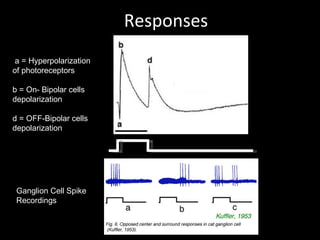
Ad
Recommended
Animal vision mabt smaller 030912
Animal vision mabt smaller 030912guisbond
Ěý
Through the eyes of an animal discusses various aspects of animal vision. It describes how scorpions fluoresce under UV light, possibly for species discrimination or navigation. It then examines the digital camera and how it is analogous to the human eye and retina. Specifically, it notes how the lens focuses light onto sensors which convert light information into electrical and digital signals, similar to how the retina works. Finally, it provides examples of experiments that can test various visual responses in animals, such as the optokinetic response, optomotor response, phototaxis, and how electrode recordings can measure neural responses to light stimuli.Animal vision
Animal vision guisbond
Ěý
The document discusses the vision capabilities of various animals, including emperor scorpions, new world monkeys, and darkling beetles, highlighting their adaptations such as nocturnal hunting and unique photoreceptor structures. It covers concepts such as scorpion fluorescence, visual reflexes, and comparative eye anatomy, emphasizing how these factors influence animal behavior. Additionally, the document mentions experiments designed to analyze eye movements and the implications for understanding both animal perception and technological advancements in imaging.About Human and animal birds eye
About Human and animal birds eyeMd Bas
Ěý
The document discusses the anatomy and functioning of the human eye, including vision mechanisms and common eye defects such as myopia, hyperopia, and cataracts. It also compares human eyes to those of animals and insects, highlighting differences in vision capabilities and adaptations. The text explains that sensory organs in the retina, namely rods and cones, play crucial roles in color detection and that various eye conditions can arise from structural changes or deficiencies.Vision in animals
Vision in animalsVani Jhaveri
Ěý
This document discusses vision in animals. It begins by introducing vision as the sense that enables animals to see their surroundings. The main organ of vision is the eye, which works with multiple parts and the brain to produce vision. Vision involves factors like field of view, depth perception, acuity, motion perception and color differentiation. Light enters the eye and a nerve impulse is sent to the brain to form an image. Vision can be monochromatic, dichromatic, trichromatic or tetrachromatic depending on the number and types of cone cells present. Some animals like snakes can see infrared light. Studying animal vision helps diagnose vision impairments.Animal Sight
Animal Sightstacybr
Ěý
Different animals perceive the world in unique ways based on their visual receptor cells and eyes. Bees have compound eyes that allow them to see ultraviolet light. Dogs have good peripheral and night vision but see a limited range of colors. Squirrels are red-green color blind and see blues, yellows, and greys. Sea turtles' visual receptors filter shorter wavelengths, allowing them to see reds, oranges, and yellows but not greens or blues. Snakes can detect infrared heat at night using pit organs and rely on movement during the day. Shrimp have basic compound eyes and rely on detecting sudden movements. Birds see a greater range of vibrant colors, including ultraviolet light, and hunting birds have outstandingAnimal Senses
Animal Sensesvacagodx
Ěý
The document discusses several animal senses that differ from human senses, including echolocation, electroreception, chemoreception, vision beyond the visible light spectrum, infrared vision, magnetoreception, and head tracking in chickens. Echolocating animals like bats use echo location to navigate and hunt by emitting calls and interpreting the returning echoes. Electroreception allows some aquatic animals to detect electric fields for navigation and hunting prey. Various animals have enhanced chemoreception, vision, infrared detection and magnetoreception abilities compared to humans.Vis 1--invertebrates-vision
Vis 1--invertebrates-visionbadsah13
Ěý
1) Invertebrates make up the vast majority of animal species and have adapted to almost every habitat through evolution of their sense organs, particularly their eyes.
2) Invertebrate eyes, though often smaller and simpler than human eyes, allow for important visual functions like seeing in dim light, perceiving many colors, and detecting rapid movement.
3) The document explores the 10 main types of invertebrate eye designs, from simple eye spots to advanced compound and camera eyes, and how different designs are suited to different visual tasks like navigation, predator avoidance, and finding food or mates.The Cognitive Science of perception
The Cognitive Science of perceptionJim Davies
Ěý
This document discusses the senses and perception. It covers:
1) How perception involves interpreting sensory information to create meaningful experiences.
2) The different sensory modalities like vision, hearing, touch, taste and smell.
3) How vision works through light entering the eye and being processed.
4) Theories on vision from the past.
5) How different cues like size, perspective and motion are used for depth perception.S. Sherrill - General Psychology - Chapter 3 power point
S. Sherrill - General Psychology - Chapter 3 power pointsjbrabham
Ěý
The document discusses sensation and perception. It defines sensation as uninterpreted messages from the senses and perception as an individual's unique interpretation based on experiences. It then provides details on the anatomy and physiology of vision, including the cornea, iris, lens, retina, optic nerve and photoreceptors. It also discusses types of color blindness and theories of color vision. Additional senses of smell, taste, touch, balance and depth perception are explained.Ch09
Ch09Jan Stern
Ěý
The eye collects light and focuses it onto the retina to form images. The retina contains photoreceptor cells that convert light into neural signals, including rods for low-light vision and cones for color vision. Within the retina, bipolar and ganglion cells process this information before sending it to the brain via the optic nerve. The lens, iris muscles, and other components help focus light and regulate the amount of light entering the eye.Color
Colorjohanna20
Ěý
This document discusses the basics of color perception. It explains that color is determined by the physics of light reflection and the physiology of human vision. Humans perceive color through three types of cone cells in the eye that are most sensitive to red, green, and blue wavelengths. Other animals, like birds and insects, may have additional cone types and perceive more colors than humans. The document also discusses concepts like hue, saturation, brightness, dichromacy, trichromacy, and tetrachromacy.sensation and perception - notes
sensation and perception - notesuploadlessons
Ěý
This document summarizes key concepts in sensation and perception. It defines sensation as the activation of receptors by stimuli and perception as the organization of sensory information into meaningful experiences. The five traditional senses are described as vision, hearing, smell, taste, and touch. Vision relies on light stimulating the eyes and optic nerve. Hearing depends on sound waves and the auditory nerve. Smell and taste are chemical senses detecting molecules. Touch provides information about pressure, warmth, cold, and pain via receptors in the skin. Perception involves organizing sensations according to Gestalt principles and making inferences to interpret the world. Depth perception allows perceiving distance using monocular and other cues.Physiology of sight and the eye
Physiology of sight and the eyeArsi University, Asella, Ethiopia
Ěý
This document discusses the physiology of sight, including:
- Light travels at high speeds and is reflected into the eyes, where it is refracted through different densities in the eye to focus on the retina.
- The retina contains light-sensitive rods and cones that detect light and color and transmit signals through the optic nerve to the brain for interpretation.
- Accommodation allows the eye to focus on near and far objects through adjustments of the lens, pupil size, and eye convergence. Refraction, the lens, and dark adaptation help facilitate clear vision.Science behind night vision camera
Science behind night vision cameraManne Thrivikram
Ěý
Night vision technologies allow humans to see in low light conditions similarly to many animals. There are two main types of night vision cameras: image intensification and thermal imaging. Image intensification uses lenses and a photocathode to amplify available light, displaying the image in green. Thermal imaging detects infrared radiation emitted from warm objects and does not require visible light. Both methods have advantages and disadvantages for military, security, and other applications.Vision de las avesCatalina RamĂrez
Ěý
Este documento describe la anatomĂa y fisiologĂa de la visiĂłn en las aves. Las aves tienen una visiĂłn mucho mejor que los humanos, con ojos proporcionalmente más grandes y sensibles a la luz ultravioleta. Sus ojos pueden tener diferentes formas adaptadas a su hábitat y dieta, y cuentan con mecanismos para enfocar rápidamente a distintas distancias. Adicionalmente, las aves son tetracromáticas y perciben cuatro colores, lo que les permite detectar alimento y señales visuales de otras aves.Vision nocturnaMerilyn Jo Jorquera
Ěý
El documento describe la visiĂłn en diferentes animales. Explica que la visiĂłn se divide en fotĂłpica, escotĂłpica y mesĂłpica, y describe las partes del ojo como la cĂłrnea, el cristalino, la retina y los fotorreceptores. Luego detalla las caracterĂsticas de la visiĂłn nocturna en gatos, perros, caballos, lĂ©mures, aves, reptiles, peces y otras especies, incluyendo detalles sobre sus ojos, pupilas, cantidad de bastones y habilidades visuales.Seminario etologia y comportamiento en la raza bonyeseniasanzp
Ěý
Este documento describe un estudio para disminuir la distancia de fuga en la raza BON mediante el manejo etolĂłgico. La raza BON se ha adaptado bien a las regiones montañosas de Colombia y tiene buena fertilidad y longevidad. El estudio evaluará el comportamiento de la raza y revisará el plan de manejo para reducir el estrĂ©s en los animales a travĂ©s de un enfoque etolĂłgico que considere su visiĂłn, comunicaciĂłn y zona de fuga.Tema10. Relacion en animalesRafa MartĂn
Ěý
El documento describe los sistemas de coordinación en los animales. Explica que los animales cuentan con dos sistemas principales: el sistema nervioso, que se encarga de las respuestas rápidas, y el sistema endocrino, que controla procesos más lentos pero duraderos. Describe la estructura y función del sistema nervioso, incluyendo la transmisión del impulso nervioso, las sinapsis y los diferentes tipos de sistemas nerviosos en invertebrados y vertebrados.Minerales en el ganado bovinoCarlitos Iñiguez
Ěý
Este documento describe los requerimientos nutricionales de minerales y vitaminas para el ganado bovino. Explica que las vacas necesitan calcio, fĂłsforo, magnesio y oligoelementos como zinc para mantener la salud, la reproducciĂłn y la producciĂłn lechera. TambiĂ©n destaca los requerimientos especĂficos durante el ciclo reproductivo, la gestaciĂłn y la lactancia. Finalmente, promueve suplementos minerales y vitamĂnicos para cubrir las necesidades del ganado y mejorar su fertilidad.La relacion en animalesadrianaahumada77
Ěý
El documento describe los sistemas sensoriales y de respuesta en los animales. Explica que los receptores captan los estĂmulos y los transmiten al sistema nervioso, que procesa la informaciĂłn y genera respuestas motoras o secretoras a travĂ©s de efectores como los mĂşsculos y glándulas. Los Ăłrganos de los sentidos varĂan entre grupos, pero generalmente incluyen receptores para la luz, sonido, tacto, quĂmicos y temperatura.EtologĂa de bovinos productores de carne 1Ambariita
Ěý
Los bovinos muestran un comportamiento gregario y rutinario, comunicándose constantemente con otros miembros del grupo. Tienen un olfato, gusto y oĂdo desarrollados que les permiten reconocer compañeros y crĂas. Pueden presentar estereotipias como bamboleo o escarbar cuando están atados o en espacios pequeños debido a la frustraciĂłn por la falta de control de su entorno.Taller cria y manejo de pollos de engordeEdgarVasquezOspina
Ěý
Este documento proporciona informaciĂłn sobre el criado y manejo de pollos de engorde. Explica que los pollos necesitan un ambiente cálido y seco, alimento y agua frescos disponibles en todo momento, y espacio suficiente para crecer. TambiĂ©n destaca la importancia de recibir los pollitos de manera adecuada, brindándoles calor, alimento y agua especĂficos para su edad durante los primeros dĂas.Vision and visual navigation in nocturnal insects
Vision and visual navigation in nocturnal insectsuvabd15122001
Ěý
Insects have extremely complex vision systems, despite their small size and relatively
small number of neurons. Insects use their compound eyes to find food sources and catch prey,
identify and avoid predators, move, swim, or fly in a complex three-dimensional environment,
navigate to and from a nest using learnt visual land marks, and recognize and respond to
conspecifics. These visual activities would be taxing enough, even in the bright, sunny world
where many insects are active. However, such activities may initially appear difficult to the
great majority of insects that are only active at night, when light levels might be up to 11 orders
of magnitude lower. Nevertheless, despite the challenging lighting circumstances they
encounter, we have started to recognize during the last 20 years that nocturnal insects carry out
the same visual tasks as their diurnal relatives and with the same precision and accuracy. This
remarkable discovery has sparked a renewed interest
in the visual talents of nocturnal insects and a greater
knowledge of how the neural system realizes these
abilities. An eye must be able to capture enough light
in order to see reliably. This essential criterion is
easily met by a diurnal (day-active) animal that is
suited for vision in bright sunshine. However,
dependable eyesight cannot be ensured at night or at
extreme water depths when light levels may be orders of magnitude lower (Warrant, 2008).
This is by no means the norm, though, as many others have made significant investments in
their eyesight and developed amazing adaptations to see well in low light (Laughlin, 1990). In
order to demonstrate some of the fundamental concepts that insects utilize to process visual
information in low light, this presentation features nocturnal insects. Insects that live in low
light typically have extremely sensitive eyes. A dependable signal is only guaranteed if every
photon that is captured is transduced effectively and consistently, even with extremely sensitive
eyes capturing as many of the available photons as possible. The photoreceptors are responsible
for this, and the degree of signal reliability at this level is determined by how well the receptors
function as photodetectors. The efficiency of insect photoreceptors is remarkable, despite their
imperfections. Optimal processing that minimizes the impacts of noise, such as summing visual
signals in space and time, can further increase the trustworthiness of the signals they send to
higher levels of the visual system. The insect’s behaviour is eventually guided by higher level
processing of visual cues, such as the size and shape of learnt landmarks, the relative
1
movements of obstacles during flight, or the colour of nectar-bearing flowers. If higher-level
processing is reliable in low light, nocturnal creatures may be able to see pretty well. Vis 1--invertebrates-vision
Vis 1--invertebrates-visionbadsah13
Ěý
- Invertebrates make up the vast majority of animal species and have adapted to almost every habitat through extraordinary diversity in sensory organs, especially eyes.
- Invertebrate eyes range from simple eye spots to advanced compound and camera eyes. They see in different spectra than humans but often see better in dim light or rapid motion.
- Ten main eye designs have evolved, from simple pits to advanced pinhole, concave mirror, compound, and camera eyes. Compound eyes are the most widespread and come in apposition and superposition types suited to different light conditions.Vision in Insects (simple eye, compound eye).pptx
Vision in Insects (simple eye, compound eye).pptxlopamudraray88
Ěý
The document discusses the vision in insects, detailing the different types of eyes, including simple eyes (dorsal ocelli and stemmata) and compound eyes, highlighting their structure and function. It explains how these eyes contribute to various visual capabilities, such as color vision, polarization sensitivity, and distance perception. Additionally, it outlines the mechanisms of image formation and the physiological characteristics of photoreceptors in insects.Insect vision
Insect visionBhumika Kapoor
Ěý
The document discusses various aspects of insect morphology related to vision, including the structure and function of compound eyes, ocelli, and stemmata. It covers image formation, color vision, polarization sensitivity, magnetic sensitivity, and the insects' ability to perceive distance and form. Additionally, it mentions the presence of other visual receptors and the impact of light on brain activity in certain species.Insectvision 161127070950
Insectvision 161127070950DiyaMalik4
Ěý
This document discusses the visual systems of insects. It describes that insects perceive light through compound eyes, ocelli, and sometimes other receptors. Compound eyes consist of many ommatidia that allow image formation and color vision. Ocelli include the dorsal ocelli in adult insects and stemmata in larval insects. Other receptors include dermal light sensors and direct brain sensitivity to light. The document focuses on these different visual receptors in insects and their functions.Evolution of EYE
Evolution of EYEGREESHMA G
Ěý
The document summarizes the evolution of eyes across different organisms. It discusses how eyes evolved independently over 40-60 times from light-sensitive cells. Early eyes were simple pits that could detect light and dark, evolving into pinhole eyes and eventually camera-style eyes with lenses. Compound eyes also evolved multiple times. The molecular basis of eye evolution involves genes like Pax6 and Hox genes. Across species, eye structures adapted for different environments and lifestyles, with variations in pupil shape, color vision, and retina anatomy in fish, amphibians, reptiles, birds, and mammals.Vision and visual navigation in nocturnal insects
Vision and visual navigation in nocturnal insectsprashantmangalgikar
Ěý
This document discusses vision and visual navigation in nocturnal insects. It begins by explaining how nocturnal insects have modified their visual systems and behavior to operate under low light conditions, which can be up to 11 orders of magnitude lower than daylight. Specifically, it discusses the optical designs of compound eyes that have evolved for high sensitivity, including superposition eyes. It also covers retinal adaptations like large photoreceptor responses, as well as strategies for enhancing vision like temporal and spatial summation in the brain. Finally, it examines how nocturnal insects navigate using celestial cues like the moon and polarized light, as well as terrestrial visual cues like tree canopies and landmarks.Photoreception (1)
Photoreception (1)Aftab Badshah
Ěý
1. Photoreception is the ability to detect light and involves photoreceptors like rods and cones that contain photopigments.
2. In the eye, light is refracted by the cornea and lens to form an image on the retina, with the fovea providing the sharpest vision.
3. Signals from photoreceptors are processed in the retina and optic nerve before reaching the visual cortex of the brain for interpretation.More Related Content
What's hot (6)
S. Sherrill - General Psychology - Chapter 3 power point
S. Sherrill - General Psychology - Chapter 3 power pointsjbrabham
Ěý
The document discusses sensation and perception. It defines sensation as uninterpreted messages from the senses and perception as an individual's unique interpretation based on experiences. It then provides details on the anatomy and physiology of vision, including the cornea, iris, lens, retina, optic nerve and photoreceptors. It also discusses types of color blindness and theories of color vision. Additional senses of smell, taste, touch, balance and depth perception are explained.Ch09
Ch09Jan Stern
Ěý
The eye collects light and focuses it onto the retina to form images. The retina contains photoreceptor cells that convert light into neural signals, including rods for low-light vision and cones for color vision. Within the retina, bipolar and ganglion cells process this information before sending it to the brain via the optic nerve. The lens, iris muscles, and other components help focus light and regulate the amount of light entering the eye.Color
Colorjohanna20
Ěý
This document discusses the basics of color perception. It explains that color is determined by the physics of light reflection and the physiology of human vision. Humans perceive color through three types of cone cells in the eye that are most sensitive to red, green, and blue wavelengths. Other animals, like birds and insects, may have additional cone types and perceive more colors than humans. The document also discusses concepts like hue, saturation, brightness, dichromacy, trichromacy, and tetrachromacy.sensation and perception - notes
sensation and perception - notesuploadlessons
Ěý
This document summarizes key concepts in sensation and perception. It defines sensation as the activation of receptors by stimuli and perception as the organization of sensory information into meaningful experiences. The five traditional senses are described as vision, hearing, smell, taste, and touch. Vision relies on light stimulating the eyes and optic nerve. Hearing depends on sound waves and the auditory nerve. Smell and taste are chemical senses detecting molecules. Touch provides information about pressure, warmth, cold, and pain via receptors in the skin. Perception involves organizing sensations according to Gestalt principles and making inferences to interpret the world. Depth perception allows perceiving distance using monocular and other cues.Physiology of sight and the eye
Physiology of sight and the eyeArsi University, Asella, Ethiopia
Ěý
This document discusses the physiology of sight, including:
- Light travels at high speeds and is reflected into the eyes, where it is refracted through different densities in the eye to focus on the retina.
- The retina contains light-sensitive rods and cones that detect light and color and transmit signals through the optic nerve to the brain for interpretation.
- Accommodation allows the eye to focus on near and far objects through adjustments of the lens, pupil size, and eye convergence. Refraction, the lens, and dark adaptation help facilitate clear vision.Science behind night vision camera
Science behind night vision cameraManne Thrivikram
Ěý
Night vision technologies allow humans to see in low light conditions similarly to many animals. There are two main types of night vision cameras: image intensification and thermal imaging. Image intensification uses lenses and a photocathode to amplify available light, displaying the image in green. Thermal imaging detects infrared radiation emitted from warm objects and does not require visible light. Both methods have advantages and disadvantages for military, security, and other applications.Viewers also liked (8)
Vision de las avesCatalina RamĂrez
Ěý
Este documento describe la anatomĂa y fisiologĂa de la visiĂłn en las aves. Las aves tienen una visiĂłn mucho mejor que los humanos, con ojos proporcionalmente más grandes y sensibles a la luz ultravioleta. Sus ojos pueden tener diferentes formas adaptadas a su hábitat y dieta, y cuentan con mecanismos para enfocar rápidamente a distintas distancias. Adicionalmente, las aves son tetracromáticas y perciben cuatro colores, lo que les permite detectar alimento y señales visuales de otras aves.Vision nocturnaMerilyn Jo Jorquera
Ěý
El documento describe la visiĂłn en diferentes animales. Explica que la visiĂłn se divide en fotĂłpica, escotĂłpica y mesĂłpica, y describe las partes del ojo como la cĂłrnea, el cristalino, la retina y los fotorreceptores. Luego detalla las caracterĂsticas de la visiĂłn nocturna en gatos, perros, caballos, lĂ©mures, aves, reptiles, peces y otras especies, incluyendo detalles sobre sus ojos, pupilas, cantidad de bastones y habilidades visuales.Seminario etologia y comportamiento en la raza bonyeseniasanzp
Ěý
Este documento describe un estudio para disminuir la distancia de fuga en la raza BON mediante el manejo etolĂłgico. La raza BON se ha adaptado bien a las regiones montañosas de Colombia y tiene buena fertilidad y longevidad. El estudio evaluará el comportamiento de la raza y revisará el plan de manejo para reducir el estrĂ©s en los animales a travĂ©s de un enfoque etolĂłgico que considere su visiĂłn, comunicaciĂłn y zona de fuga.Tema10. Relacion en animalesRafa MartĂn
Ěý
El documento describe los sistemas de coordinación en los animales. Explica que los animales cuentan con dos sistemas principales: el sistema nervioso, que se encarga de las respuestas rápidas, y el sistema endocrino, que controla procesos más lentos pero duraderos. Describe la estructura y función del sistema nervioso, incluyendo la transmisión del impulso nervioso, las sinapsis y los diferentes tipos de sistemas nerviosos en invertebrados y vertebrados.Minerales en el ganado bovinoCarlitos Iñiguez
Ěý
Este documento describe los requerimientos nutricionales de minerales y vitaminas para el ganado bovino. Explica que las vacas necesitan calcio, fĂłsforo, magnesio y oligoelementos como zinc para mantener la salud, la reproducciĂłn y la producciĂłn lechera. TambiĂ©n destaca los requerimientos especĂficos durante el ciclo reproductivo, la gestaciĂłn y la lactancia. Finalmente, promueve suplementos minerales y vitamĂnicos para cubrir las necesidades del ganado y mejorar su fertilidad.La relacion en animalesadrianaahumada77
Ěý
El documento describe los sistemas sensoriales y de respuesta en los animales. Explica que los receptores captan los estĂmulos y los transmiten al sistema nervioso, que procesa la informaciĂłn y genera respuestas motoras o secretoras a travĂ©s de efectores como los mĂşsculos y glándulas. Los Ăłrganos de los sentidos varĂan entre grupos, pero generalmente incluyen receptores para la luz, sonido, tacto, quĂmicos y temperatura.EtologĂa de bovinos productores de carne 1Ambariita
Ěý
Los bovinos muestran un comportamiento gregario y rutinario, comunicándose constantemente con otros miembros del grupo. Tienen un olfato, gusto y oĂdo desarrollados que les permiten reconocer compañeros y crĂas. Pueden presentar estereotipias como bamboleo o escarbar cuando están atados o en espacios pequeños debido a la frustraciĂłn por la falta de control de su entorno.Taller cria y manejo de pollos de engordeEdgarVasquezOspina
Ěý
Este documento proporciona informaciĂłn sobre el criado y manejo de pollos de engorde. Explica que los pollos necesitan un ambiente cálido y seco, alimento y agua frescos disponibles en todo momento, y espacio suficiente para crecer. TambiĂ©n destaca la importancia de recibir los pollitos de manera adecuada, brindándoles calor, alimento y agua especĂficos para su edad durante los primeros dĂas.Ad
Similar to Animal vision nsta 102911 (20)
Vision and visual navigation in nocturnal insects
Vision and visual navigation in nocturnal insectsuvabd15122001
Ěý
Insects have extremely complex vision systems, despite their small size and relatively
small number of neurons. Insects use their compound eyes to find food sources and catch prey,
identify and avoid predators, move, swim, or fly in a complex three-dimensional environment,
navigate to and from a nest using learnt visual land marks, and recognize and respond to
conspecifics. These visual activities would be taxing enough, even in the bright, sunny world
where many insects are active. However, such activities may initially appear difficult to the
great majority of insects that are only active at night, when light levels might be up to 11 orders
of magnitude lower. Nevertheless, despite the challenging lighting circumstances they
encounter, we have started to recognize during the last 20 years that nocturnal insects carry out
the same visual tasks as their diurnal relatives and with the same precision and accuracy. This
remarkable discovery has sparked a renewed interest
in the visual talents of nocturnal insects and a greater
knowledge of how the neural system realizes these
abilities. An eye must be able to capture enough light
in order to see reliably. This essential criterion is
easily met by a diurnal (day-active) animal that is
suited for vision in bright sunshine. However,
dependable eyesight cannot be ensured at night or at
extreme water depths when light levels may be orders of magnitude lower (Warrant, 2008).
This is by no means the norm, though, as many others have made significant investments in
their eyesight and developed amazing adaptations to see well in low light (Laughlin, 1990). In
order to demonstrate some of the fundamental concepts that insects utilize to process visual
information in low light, this presentation features nocturnal insects. Insects that live in low
light typically have extremely sensitive eyes. A dependable signal is only guaranteed if every
photon that is captured is transduced effectively and consistently, even with extremely sensitive
eyes capturing as many of the available photons as possible. The photoreceptors are responsible
for this, and the degree of signal reliability at this level is determined by how well the receptors
function as photodetectors. The efficiency of insect photoreceptors is remarkable, despite their
imperfections. Optimal processing that minimizes the impacts of noise, such as summing visual
signals in space and time, can further increase the trustworthiness of the signals they send to
higher levels of the visual system. The insect’s behaviour is eventually guided by higher level
processing of visual cues, such as the size and shape of learnt landmarks, the relative
1
movements of obstacles during flight, or the colour of nectar-bearing flowers. If higher-level
processing is reliable in low light, nocturnal creatures may be able to see pretty well. Vis 1--invertebrates-vision
Vis 1--invertebrates-visionbadsah13
Ěý
- Invertebrates make up the vast majority of animal species and have adapted to almost every habitat through extraordinary diversity in sensory organs, especially eyes.
- Invertebrate eyes range from simple eye spots to advanced compound and camera eyes. They see in different spectra than humans but often see better in dim light or rapid motion.
- Ten main eye designs have evolved, from simple pits to advanced pinhole, concave mirror, compound, and camera eyes. Compound eyes are the most widespread and come in apposition and superposition types suited to different light conditions.Vision in Insects (simple eye, compound eye).pptx
Vision in Insects (simple eye, compound eye).pptxlopamudraray88
Ěý
The document discusses the vision in insects, detailing the different types of eyes, including simple eyes (dorsal ocelli and stemmata) and compound eyes, highlighting their structure and function. It explains how these eyes contribute to various visual capabilities, such as color vision, polarization sensitivity, and distance perception. Additionally, it outlines the mechanisms of image formation and the physiological characteristics of photoreceptors in insects.Insect vision
Insect visionBhumika Kapoor
Ěý
The document discusses various aspects of insect morphology related to vision, including the structure and function of compound eyes, ocelli, and stemmata. It covers image formation, color vision, polarization sensitivity, magnetic sensitivity, and the insects' ability to perceive distance and form. Additionally, it mentions the presence of other visual receptors and the impact of light on brain activity in certain species.Insectvision 161127070950
Insectvision 161127070950DiyaMalik4
Ěý
This document discusses the visual systems of insects. It describes that insects perceive light through compound eyes, ocelli, and sometimes other receptors. Compound eyes consist of many ommatidia that allow image formation and color vision. Ocelli include the dorsal ocelli in adult insects and stemmata in larval insects. Other receptors include dermal light sensors and direct brain sensitivity to light. The document focuses on these different visual receptors in insects and their functions.Evolution of EYE
Evolution of EYEGREESHMA G
Ěý
The document summarizes the evolution of eyes across different organisms. It discusses how eyes evolved independently over 40-60 times from light-sensitive cells. Early eyes were simple pits that could detect light and dark, evolving into pinhole eyes and eventually camera-style eyes with lenses. Compound eyes also evolved multiple times. The molecular basis of eye evolution involves genes like Pax6 and Hox genes. Across species, eye structures adapted for different environments and lifestyles, with variations in pupil shape, color vision, and retina anatomy in fish, amphibians, reptiles, birds, and mammals.Vision and visual navigation in nocturnal insects
Vision and visual navigation in nocturnal insectsprashantmangalgikar
Ěý
This document discusses vision and visual navigation in nocturnal insects. It begins by explaining how nocturnal insects have modified their visual systems and behavior to operate under low light conditions, which can be up to 11 orders of magnitude lower than daylight. Specifically, it discusses the optical designs of compound eyes that have evolved for high sensitivity, including superposition eyes. It also covers retinal adaptations like large photoreceptor responses, as well as strategies for enhancing vision like temporal and spatial summation in the brain. Finally, it examines how nocturnal insects navigate using celestial cues like the moon and polarized light, as well as terrestrial visual cues like tree canopies and landmarks.Photoreception (1)
Photoreception (1)Aftab Badshah
Ěý
1. Photoreception is the ability to detect light and involves photoreceptors like rods and cones that contain photopigments.
2. In the eye, light is refracted by the cornea and lens to form an image on the retina, with the fovea providing the sharpest vision.
3. Signals from photoreceptors are processed in the retina and optic nerve before reaching the visual cortex of the brain for interpretation.Vision and visual navigation in nocturnal insects-SSNAIK TNAU
Vision and visual navigation in nocturnal insects-SSNAIK TNAUAsst Prof SSNAIK ENTO PJTSAU
Ěý
The document is a comprehensive study on the vision and navigation of nocturnal insects, detailing their adaptations and physiological structures, particularly in their optical systems. It covers historical insights into insect vision, types of eyes, visual tasks, and navigation techniques using celestial and terrestrial cues. The study emphasizes the significance of visual systems in nocturnal behaviors and highlights ongoing research in this field.Vision and visual navigation in nocturnal insects
Vision and visual navigation in nocturnal insectsAaliya Afroz
Ěý
This document discusses the visual navigation abilities of nocturnal insects, highlighting their adaptations for low-light environments through enhanced optical sensitivity and neural mechanisms facilitating perception. It describes how these insects utilize celestial cues and terrestrial landmarks for navigation and emphasizes their remarkable capacity to discriminate colors and orient themselves using faint signals. The conclusion suggests further research into the neural strategies involved in visual processing for nocturnal insects is needed, as their evolutionary adaptations showcase a complex interaction between retinal signaling and behavior.insect vision, entomology, insect eye facet
insect vision, entomology, insect eye facetagri20
Ěý
Insects perceive light through various visual receptors including compound eyes, ocelli, and stemmata. Compound eyes consist of thousands of ommatidia, each with optical and sensory parts containing photoreceptor cells. Compound eyes form either apposition or superposition images and provide benefits like motion detection, distance perception, and visual tracking. Some insects are sensitive to different colors and intensities of light. In addition to compound eyes, adult insects and larval hemimetabolous insects have dorsal ocelli while larval holometabolous insects have lateral stemmata for light perception. Some insects also have dermal or brain light receptors.Photoreception
PhotoreceptionAftab Badshah
Ěý
Photoreception involves the ability to detect light across the electromagnetic spectrum using light-sensitive organs like eyes. There are two main types of photoreceptors - ciliary and rhabdomeric. Photopigments contain a chromophore molecule like retinal that absorbs photons and changes shape, triggering signal transduction cascades in the photoreceptor cell. Eyes have evolved from simple eyespots in single cells to complex image-forming eyes like the vertebrate eye, which uses refraction by the cornea and lens to focus light onto the retina. In the retina, rods are more numerous and provide low-light vision while cones provide high-resolution color vision in bright light. The visual signal is then processedJAndrew/Compound eye.pptx
JAndrew/Compound eye.pptxshakinadeiv1
Ěý
Compound eyes are found in most adult insects and hemimetabolous insect larvae. They are constructed from many light-sensing units called ommatidia, each containing photoreceptor cells that form images. Ocelli are simple light-detecting organs that detect movement, with most insects possessing 3 dorsal ocelli on the head. Both compound eyes and ocelli transmit light signals to the brain via photoreceptor cells, interneurons, and neural connections, allowing insects to process visual information.PHOTORECEPTION. .......pptx
PHOTORECEPTION. .......pptxNeha Elizabeth Koshy
Ěý
This document summarizes photoreception and the different types of photoreceptors across animals. It discusses that photoreception involves light detection by specialized photoreceptor cells. Photoreceptors vary between animals and include cup-shaped eyes in flatworms, compound eyes made of ommatidia in arthropods, and rods and cones in vertebrates. The document also describes the molecular mechanisms of photoreception involving photopigments like rhodopsin and their signal transduction pathways, as well as differences between invertebrate and vertebrate neural transmission in light and dark conditions.Vision
Visionbadsah13
Ěý
This document discusses the evolution of photoreception and vision. It describes the different types of photoreceptor cells and eyes that evolved in lower invertebrates including pigmented epithelia in corals, eye cups in flatworms, and lensed eyes in cubomedusae jellyfish. It then focuses on the advanced camera eyes that evolved independently in molluscs like cephalopods and the compound eyes of arthropods. The evolution of eyes is considered one of the best examples of convergent evolution, with estimates that eyes evolved over 40 times across different phyla utilizing similar genetic regulatory mechanisms.Vision
Visionbadsah13
Ěý
This document discusses the evolution of photoreception and vision. It describes the different types of photoreceptor cells and eyes that evolved in lower invertebrates including pigmented epithelia in corals, eye cups in flatworms, and lensed eyes in cubomedusae jellyfish. It then focuses on the advanced camera eyes that evolved independently in molluscs like cephalopods and the compound eyes of arthropods. The evolution of eyes is considered one of the prime examples of convergent evolution, with estimates that eyes evolved over 40 times across different phyla utilizing similar genetic regulatory mechanisms.Color vision
Color visionguisbond
Ěý
This document outlines the workshop "Science of the Eye Professional Development Workshop" presented by Ishara Mills-Henry, Ph.D. from MIT. The workshop covers color vision and the retina, vision and the brain, and includes activities to teach concepts like phototransduction, color blindness, and optical illusions. Feedback from participants will be gathered at the end to improve future workshops. The goal is to teach vision science concepts in an engaging way and address common misconceptions.Eye powerpoint
Eye powerpointanatomyoftheeye
Ěý
This document summarizes a collaboration project on the anatomy, physiology, genetics, and evolution of the eye. It discusses the anatomy of the iris and pupil. It describes the physiology of vision including refraction, accommodation, and visual processing in the brain. It covers genetics of eye development including the role of the Pax6 gene. Finally, it discusses the evolution of light-sensitive proteins, development of simple eyes, and adaptations involving the lens, color vision, and eye movement.Tractatus vision system evolution in metazoan-RESEARCHGATE luisetto m et al 2020
Tractatus vision system evolution in metazoan-RESEARCHGATE luisetto m et al 2020M. Luisetto Pharm.D.Spec. Pharmacology
Ěý
This document summarizes the evolution of vision systems in metazoans and discusses how understanding this evolution can help with regenerative medicine approaches. It traces how early light-sensing cells in simple organisms gradually evolved into advanced eye structures through environmental pressures and genetic changes over hundreds of thousands of generations. Key stages discussed include the development of eyespots, simple eye cups, advanced camera-style eyes, and compound eyes. Examining differences in eye structures and regeneration abilities across metazoan species can provide insight into why some advanced vertebrates lost retinal regeneration potential and ways to potentially restore this ability through targeting inhibitory factors.Visual Ecology Thomas W Cronin Snke Johnsen N Justin Marshall
Visual Ecology Thomas W Cronin Snke Johnsen N Justin Marshallrvztucerr9390
Ěý
Visual Ecology Thomas W Cronin Snke Johnsen N Justin Marshall
Visual Ecology Thomas W Cronin Snke Johnsen N Justin Marshall
Visual Ecology Thomas W Cronin Snke Johnsen N Justin MarshallTractatus vision system evolution in metazoan-RESEARCHGATE luisetto m et al 2020
Tractatus vision system evolution in metazoan-RESEARCHGATE luisetto m et al 2020M. Luisetto Pharm.D.Spec. Pharmacology
Ěý
Ad
Recently uploaded (20)
LAZY SUNDAY QUIZ "A GENERAL QUIZ" JUNE 2025 SMC QUIZ CLUB, SILCHAR MEDICAL CO...
LAZY SUNDAY QUIZ "A GENERAL QUIZ" JUNE 2025 SMC QUIZ CLUB, SILCHAR MEDICAL CO...Ultimatewinner0342
Ěý
🧠Lazy Sunday Quiz | General Knowledge Trivia by SMC Quiz Club – Silchar Medical College
Presenting the Lazy Sunday Quiz, a fun and thought-provoking general knowledge quiz created by the SMC Quiz Club of Silchar Medical College & Hospital (SMCH). This quiz is designed for casual learners, quiz enthusiasts, and competitive teams looking for a diverse, engaging set of questions with clean visuals and smart clues.
🎯 What is the Lazy Sunday Quiz?
The Lazy Sunday Quiz is a light-hearted yet intellectually rewarding quiz session held under the SMC Quiz Club banner. It’s a general quiz covering a mix of current affairs, pop culture, history, India, sports, medicine, science, and more.
Whether you’re hosting a quiz event, preparing a session for students, or just looking for quality trivia to enjoy with friends, this PowerPoint deck is perfect for you.
đź“‹ Quiz Format & Structure
Total Questions: ~50
Types: MCQs, one-liners, image-based, visual connects, lateral thinking
Rounds: Warm-up, Main Quiz, Visual Round, Connects (optional bonus)
Design: Simple, clear slides with answer explanations included
Tools Needed: Just a projector or screen – ready to use!
🧠Who Is It For?
College quiz clubs
School or medical students
Teachers or faculty for classroom engagement
Event organizers needing quiz content
Quizzers preparing for competitions
Freelancers building quiz portfolios
đź’ˇ Why Use This Quiz?
Ready-made, high-quality content
Curated with lateral thinking and storytelling in mind
Covers both academic and pop culture topics
Designed by a quizzer with real event experience
Usable in inter-college fests, informal quizzes, or Sunday brain workouts
đź“š About the Creators
This quiz has been created by Rana Mayank Pratap, an MBBS student and quizmaster at SMC Quiz Club, Silchar Medical College. The club aims to promote a culture of curiosity and smart thinking through weekly and monthly quiz events.
🔍 SEO Tags:
quiz, general knowledge quiz, trivia quiz, şÝşÝߣShare quiz, college quiz, fun quiz, medical college quiz, India quiz, pop culture quiz, visual quiz, MCQ quiz, connect quiz, science quiz, current affairs quiz, SMC Quiz Club, Silchar Medical College
đź“Ł Reuse & Credit
You’re free to use or adapt this quiz for your own events or sessions with credit to:
SMC Quiz Club – Silchar Medical College & Hospital
Curated by: Rana Mayank PratapPeer Teaching Observations During School Internship
Peer Teaching Observations During School InternshipAjayaMohanty7
Ěý
FOR B.ED,M.ED,M.A.EDUCATION AND ANY STUDENT OF TEACHER EDUCATIONLearning Styles Inventory for Senior High School Students
Learning Styles Inventory for Senior High School StudentsThelma Villaflores
Ěý
Learning styles inventory, learning strategies, visual learners, auditory learners, kinesthetic learners, tactile learners, read/write learnersHow to use search fetch method in Odoo 18
How to use search fetch method in Odoo 18Celine George
Ěý
The search_fetch is a powerful ORM method used in Odoo for some specific addons to combine the functionality of search and read for more efficient data fetching. It might be used to search for records and fetch specific fields in a single call. It stores the result in the cache memory.YSPH VMOC Special Report - Measles Outbreak Southwest US 6-14-2025.pptx
YSPH VMOC Special Report - Measles Outbreak Southwest US 6-14-2025.pptxYale School of Public Health - The Virtual Medical Operations Center (VMOC)
Ěý
BLUF:
The Texas outbreak has slowed down, but sporadic cases continue to emerge in Kansas, Oklahoma, and New Mexico.
Elsewhere in the US, we continue to see signs of acceleration due to outbreaks outside the Southwest (North Dakota, Montana, and Colorado) and travel-related cases. Measles exposures due to travel are expected to pose a significant challenge throughout the summer.
The U.S. is on track to exceed its 30-year high for measles cases (1,274) within the next two weeks.
Here is the latest update:
CURRENT CASE COUNT: 919
•Texas: 744 (+2) (55% of cases are in Gaines County).
•New Mexico: 81 (83% of cases are from Lea County).
•Oklahoma: 20 (+2)
•Kansas: 74 (+5) (38.89% of the cases are from Gray County).
HOSPITALIZATIONS: 104
• Texas: 96 (+2) – This accounts for 13% of all cases in Texas.
• New Mexico: 7 – This accounts for 9.47% of all cases in New Mexico.
• Kansas: 3 – This accounts for 5.08% of all cases in the state of Kansas.
DEATHS: 3
•Texas: 2 – This is 0.27% of all cases in Texas.
•New Mexico: 1 – This is 1.23% of all cases in New Mexico.
US NATIONAL CASE COUNT: 1,197
INTERNATIONAL SPREAD
•Mexico: 2337 (+257), 5 fatalities
‒Chihuahua, Mexico: 2,179 (+239) cases, 4 fatalities, 7 currently hospitalized.
•Canada: 3,207 (+208), 1 fatality
‒Ontario Outbreak, Canada: 2,115 (+74) cases, 158 hospitalizations, 1 fatality.
‒Alberta, Canada: 879(+118) cases, 5 currently hospitalized.Gladiolous Cultivation practices by AKL.pdf
Gladiolous Cultivation practices by AKL.pdfkushallamichhame
Ěý
This includes the overall cultivation practices of Rose prepared by:
Kushal Lamichhane (AKL)
Instructor
Shree Gandhi Adarsha Secondary School
Kageshowri Manohara-09, Kathmandu, Nepal
THE PSYCHOANALYTIC OF THE BLACK CAT BY EDGAR ALLAN POE (1).pdf
THE PSYCHOANALYTIC OF THE BLACK CAT BY EDGAR ALLAN POE (1).pdfnabilahk908
Ěý
Psychoanalytic Analysis of The Black Cat by Edgar Allan Poe explores the deep psychological dimensions of the narrator’s disturbed mind through the lens of Sigmund Freud’s psychoanalytic theory. According to Freud (1923), the human psyche is structured into three components: the Id, which contains primitive and unconscious desires; the Ego, which operates on the reality principle and mediates between the Id and the external world; and the Superego, which reflects internalized moral standards.
In this story, Poe presents a narrator who experiences a psychological breakdown triggered by repressed guilt, aggression, and internal conflict. This analysis focuses not only on the gothic horror elements of the narrative but also on the narrator’s mental instability and emotional repression, demonstrating how the imbalance of these three psychic forces contributes to his downfall.ECONOMICS, DISASTER MANAGEMENT, ROAD SAFETY - STUDY MATERIAL [10TH]
ECONOMICS, DISASTER MANAGEMENT, ROAD SAFETY - STUDY MATERIAL [10TH]SHERAZ AHMAD LONE
Ěý
This study material for Class 10th covers the core subjects of Economics, Disaster Management, and Road Safety Education, developed strictly in line with the JKBOSE textbook. It presents the content in a simplified, structured, and student-friendly format, ensuring clarity in concepts. The material includes reframed explanations, flowcharts, infographics, and key point summaries to support better understanding and retention. Designed for classroom teaching and exam preparation, it aims to enhance comprehension, critical thinking, and practical awareness among students.How to Add New Item in CogMenu in Odoo 18
How to Add New Item in CogMenu in Odoo 18Celine George
Ěý
In Odoo 18, CogMenu (or Configuration Menu) is a feature typically found in various modules that allows users to configure settings related to that specific module. It has a cogwheel like icon usually located on the top left side of the screen. By default, the features for Importing and Exporting will be available inside the menu.VCE Literature Section A Exam Response Guide
VCE Literature Section A Exam Response Guidejpinnuck
Ěý
This practical guide shows students of Unit 3&4 VCE Literature how to write responses to Section A of the exam. Including a range of examples writing about different types of texts, this guide:
*Breaks down and explains what Q1 and Q2 tasks involve and expect
*Breaks down example responses for each question
*Explains and scaffolds students to write responses for each question
*Includes a comprehensive range of sentence starters and vocabulary for responding to each question
*Includes critical theory vocabularyĚý lists to support Q2 responsesHow payment terms are configured in Odoo 18
How payment terms are configured in Odoo 18Celine George
Ěý
Payment terms in Odoo 18 help define the conditions for when invoices are due. This feature can split payments into multiple parts and automate due dates based on specific rules.2025 June Year 9 Presentation: Subject selection.pptx
2025 June Year 9 Presentation: Subject selection.pptxmansk2
Ěý
2025 June Year 9 Presentation: Subject selectionBirnagar High School Platinum Jubilee Quiz.pptx
Birnagar High School Platinum Jubilee Quiz.pptxSourav Kr Podder
Ěý
Birnagar High School Platinum Jubilee Celebration QuizLDMMIA Shop & Student News Summer Solstice 25
LDMMIA Shop & Student News Summer Solstice 25LDM & Mia eStudios
Ěý
6/18/25
Shop, Upcoming: Final Notes to Review as we Close Level One. Make sure to review the orientation and videos as well. There’s more to come and material to cover in Levels 2-3. The content will be a combination of Reiki and Yoga. Also energy topics of our spiritual collective.
Thanks again all future Practitioner Level Students. Our Levels so far are: Guest, Grad, and Practitioner. We have had over 5k Spring Views.
https://ldm-mia.creator-spring.comAprendendo Arquitetura Framework Salesforce - Dia 02
Aprendendo Arquitetura Framework Salesforce - Dia 02Mauricio Alexandre Silva
Ěý
Aprendendo Arquitetura Framework Salesforce - Dia 02
June 2025 Progress Update With Board Call_In process.pptx
June 2025 Progress Update With Board Call_In process.pptxInternational Society of Service Innovation Professionals
Ěý
---
June 25 ISSIP Event - slides in process
20250618 PPre-Event Presentation Summary - Progress Update with Board Series June 25
ISSIP Website Upcoming Events Description: https://issip.org/event/semi-annual-issip-progress-call/
Register here (even if you cannot attend live online, all who register will get link to recording and slides post-event): https://docs.google.com/forms/d/e/1FAIpQLSdThrop1rafOCo4PQkYiS2XApclJuMjYONEHRMGBsceRdcQqg/viewform
This pre-event presentation: /slideshow/june-2025-progress-update-with-board-call_in-process-pptx/280718770
This pre-event recording: https://youtu.be/Shjgd5o488o
---LAZY SUNDAY QUIZ "A GENERAL QUIZ" JUNE 2025 SMC QUIZ CLUB, SILCHAR MEDICAL CO...
LAZY SUNDAY QUIZ "A GENERAL QUIZ" JUNE 2025 SMC QUIZ CLUB, SILCHAR MEDICAL CO...Ultimatewinner0342
Ěý
YSPH VMOC Special Report - Measles Outbreak Southwest US 6-14-2025.pptx
YSPH VMOC Special Report - Measles Outbreak Southwest US 6-14-2025.pptxYale School of Public Health - The Virtual Medical Operations Center (VMOC)
Ěý
June 2025 Progress Update With Board Call_In process.pptx
June 2025 Progress Update With Board Call_In process.pptxInternational Society of Service Innovation Professionals
Ěý
Animal vision nsta 102911
- 1. Through the eyes of an animal: how animals see Ishara Mills-Henry, Ph.D. Science of the Eye Program MIT
- 2. Ěý
- 3. Ěý
- 4. Ěý
- 5. Ěý
- 6. Ěý
- 7. What do animals see?
- 8. What do animals see?
- 9. The Retina From www.howstuffworks.com Retina
- 10. Retina Humans are considered trichromats Blue, Red, and Green Cone Photorecpetors Rod photoreceptors – are important for vision in dim light
- 11. Rods – Low light Cones – Color vision Three Main Parts: a. Outer Segments b. Cell body c. Synaptic terminal
- 12. Visual Responses Optokinetic Response/Reflex Maintain image on retina stable Innate reflex Optomotor Response/Reflex Locomotive behavior Hypothesized to play a role in control of speed and direction of body movement Innate reflex Escape or Avoidance Response Avert danger Innate reflex Ability to test: Colors, Spatial frequency, and Motion detection
- 13. Observing our eye movements Umbrellas Groups of three One person twists an umbrella while the other tries to focus on the umbrella without moving their eyes. The third person can observe. The umbrella should have a pattern or make stripes on a solid color umbrella with tape
- 14. Eye movements (microsaccades) http://www.michaelbach.de/ot/mot_eyeJitter/index.html from Pinna B & Spillmann L (2002) A new illusion of floating motion in depth. Perception 31:1501–1502. Involuntary eye movements – This illusion makes us aware of the small movements our eyes make. Our eyes these movements even if we think we are focusing on an object. This is to prevent the photoreceptors in the retina from desensitizing. If photoreceptors desensitize they will no longer pass the signal to the brain of the object we are seeing. It would reduce the visibility of an object.
- 15. Drum lined with black and white stripes Light source illuminates drum
- 16. Optokinetic Response Vertebrates exhibit numerous reflex behaviors that are driven by visual stimuli. The OKR response encompasses smooth eye rotations which track moving patterns followed by sharp movements called saccades.
- 17. Optomotor Response Zebrafish ( http://baierlab.ucsf.edu/omr.html )
- 18. Escape or Avoidance Response
- 19. Compound Eyes From http://universe-review.ca/R10-33-anatomy.htm Repetitive facets called ommatidia Image formation probably more of a mosaic than individual images (But the glasses are still fun)
- 20. House crickets ( Acheta domesticus) Omnivorous scavengers Feed on organic materials, as well as decaying plant material, fungi, and some seedling plants Active mostly at night Have UV (332 nm), blue (445 nm), and green (515 nm) Habitat: Forest and grasslands See polarized light (navigation purposes) Detect visual cues for place memory
- 21. Phototaxis Movement towards or away from light
- 22. Drosophila Habitat: rotting fruit Phototaxis Eight photoreceptors arranged in a pattern Vision: myopic/poor spatial quality but able to detect movement quickly Smaller lenses captures less light
- 23. Mealworms/Darkling Beetles ( tenebrio moliter) Over 20,000 species Larval stages are used as a food source fish, reptiles, and birds. Adult darkling beetles – active both day and night Habitat: burrows in grain Eat mostly vegetation – fresh and decaying Spectral response – 520 nm and 334 – 365 nm (UV) Do they exhibit negative or positive phototaxis? Does the larval stage behavior differ from the adult stage?
- 24. Planaria ( Schmidtea mediterranea) Flatworms Usually used to study regeneration Habitat: Under rocks in river beds Eye contains pigment and photoreceptor cells
- 25. Emperor Scorpions ( Pandinus imperator) Found in the tropical forests and savannas of Africa Docile, although can become territorial and cannibalistic Nocturnal –hunts for prey at night Habitat: under rocks, logs, and other forest debris
- 26. Scorpion Fluorescence Scorpions fluorescence under UV light. Exoskeleton contains compounds that exhibit flourescence Recent studies suggested its for detection and avoidance of the UV light. Ability to discriminate between species? Mating, navigation, ?)
- 27. More Interesting Information Flight Simulator for flies? May yield info for Robot Vision http://www.youtube.com/watch?v=e5uPr_3SsHA&feature=player_embedded
- 28. What can animals with compound eyes teach us? Better Cameras and motion detection systems?
- 29. Measuring Responses Place electrode on eye Light stimulus flashes over the eye
- 30. Responses Ganglion Cell Spike Recordings a = Hyperpolarization of photoreceptors b = On- Bipolar cells depolarization d = OFF-Bipolar cells depolarization